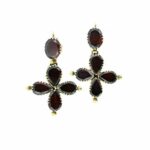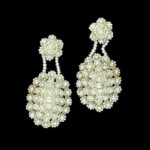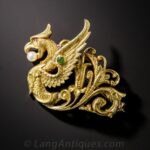In a nostalgic wave created by the celebration of the country’s 50th anniversary, Americans began to take pride in previous generations and a mid-eighteenth century revival was born. In this time of relative prosperity, jewelry inherited from grandparents was remodeled and incorporated into modern styling. Blue enamel plaques with diamond accents were popular again. Flowers and contemporary sentiments began to dominate jewelry styling. Designs containing secret messages couched in “the language of flowers” were widely embraced and Etruscan, Roman, and Byzantine themes were appearing on the American jewelry scene.
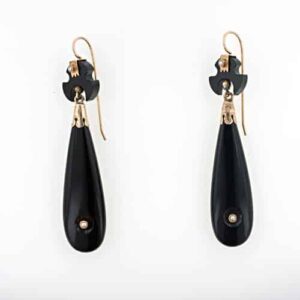
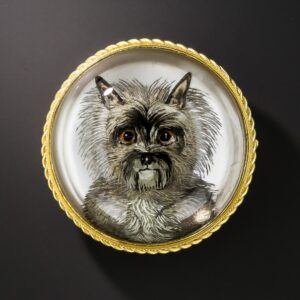
This revival of eighteenth-century styling included some modifications. Earrings were long with detachable pendants. A popular earring pendant during this time was a tapered drop shape with a rounded bottom. Ball drops, hoops, filigree, and tassels were included in the mix. More open necklines called for larger necklaces and a tapering necklace with a central medallion became the fashion. Lockets with memento compartments were characteristic of this era. A new decorative jewelry element, the reverse crystal intaglio, was invented. This technique took a rock crystal quartz cabochon and featured an intaglio or picture carved on the backside which was colored before mounting.
Brooches included cameos framed simply or framed ornately, bar brooches with wirework and granulation, and pivoting brooches with a miniature on one side and hairwork on the other. Bracelets were widened with a central bulge decorated by a large monogram or medallion, and for comfort, they were constructed in sections and hinged. Manchettes also briefly enjoyed the spotlight, imitating lacework cuffs in beautifully worked gold.
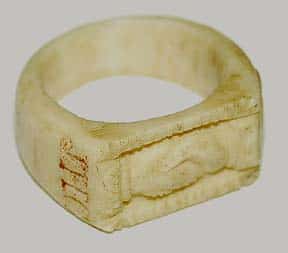
For men, elaborate vest buttons and shirt studs grew very large. Bold watch chains with multiple dangling keys and revolving seal fobs along with signet rings and gold-topped canes were all the rage. Dress sets comprised of cuff links and shirt studs sometimes included a shirt pin or stickpin and vest buttons.
Rings became heavier with more decorative elements. Garnet, amethyst, emerald, and diamond continued to be the most popular gems to set in rings. Emblematic rings gained momentum with the U.S. Naval Academy and West Point adopting symbolic rings with a class motto. Bloodstone was a popular gemstone for these rings because of its long history of being worn into battle. The Freemasons continued their new tradition of wearing symbolic jewelry adding rings to their collection. Some Civil War soldiers wore rings that could be used for identification purposes and many soldiers and prisoners of war passed time by carving rings from whatever material was at hand, including bone and wood. Rings carved in this manner often had designs on them to indicate which prison camp the carver was detained in. With the invention of die striking machinery, mass production of rings became possible, changing the way jewelry was made forever.
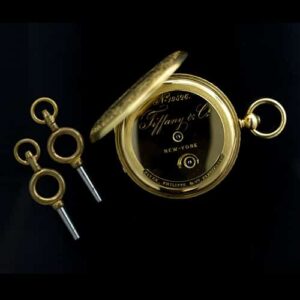
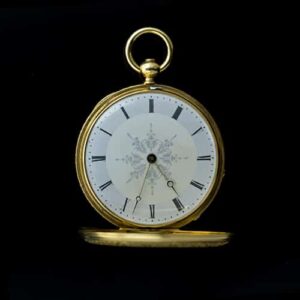
Watch manufacturing in America gained momentum in the 1830s with new machinery for tooling the necessary parts being a key component in the industry’s success. The drive to produce American-made watches led to many inventions and patents for making the necessary precision elements, further fueling the rapidly growing industrialization of the United States. An entire industry grew up around American watchmaking including jewelers specializing in watch cases, engravers, gem cutters and chain makers, all necessary to feed the growing industry. Nevertheless, Swiss watches were still considered the standard and retailers such as Tiffany began to import Patek Philippe movements in 1847 to put in their watches.
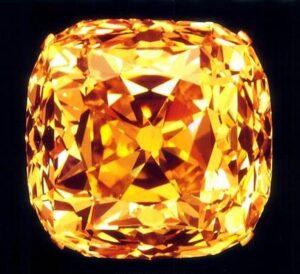
In 1828 a tariff was imposed on the importation of manufactured goods. In an effort to retain their profits, jewelers switched to the importation of unmounted diamonds and began manufacturing their own jewelry to set them in. The demand for diamond jewelry grew exponentially as more and more people had the means to afford it. Meanwhile, in France, with the rise of the second republic and the attendant revolutionary fervor, there was a glut of diamonds on the market, including the French Crown Jewels. Tiffany’s purchasing agent over there took full advantage of the situation and was able to acquire diamond goods at a fraction of their value. The name Tiffany became synonymous with “The King of Diamonds”1and their Paris branch set them apart from the rest of the New York jewelry trade.
In 1859 a “Diamond Wedding” took place in New York between Frances Amelia Bartlett and the wealthy Don Esteban Santa Cruz de Oviedo (a Cuban citizen). The bride received a magnificent parure created by Tiffany & Co. composed of pearls and diamonds unlike anything previously seen outside of the courts of Europe. Ball, Black & Co. also created elaborate jewels for the bridal trousseau. The total value of all the jewelry created by the two firms for the bride was estimated at $90,000. The entire affair was a tribute to the American jewelry firms who created these amazing jewels and the widespread publicity of the event fueled a bridal jewelry revolution in America.
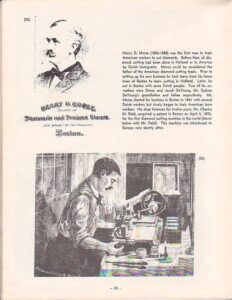
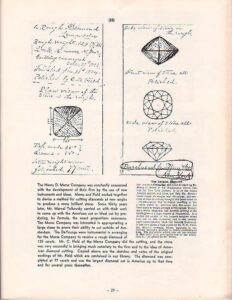 Henry D. Morse of Boston, a trained silversmith, became interested in diamonds. With the influx of diamonds from S. Africa, Morse partnered with importer B.S. Pray and together they established the first diamond-cutting company in the United States. In their early days, they employed skilled diamond cutters from Antwerp who maintained deep secrecy surrounding their diamond-cutting methods. Eventually, though, Morse gleaned enough knowledge from his employees to be able to begin experimenting with diamond cutting himself. Morse then covertly trained American men and women in the art and skill of diamond fashioning and the American diamond-cutting industry was thus born.
Henry D. Morse of Boston, a trained silversmith, became interested in diamonds. With the influx of diamonds from S. Africa, Morse partnered with importer B.S. Pray and together they established the first diamond-cutting company in the United States. In their early days, they employed skilled diamond cutters from Antwerp who maintained deep secrecy surrounding their diamond-cutting methods. Eventually, though, Morse gleaned enough knowledge from his employees to be able to begin experimenting with diamond cutting himself. Morse then covertly trained American men and women in the art and skill of diamond fashioning and the American diamond-cutting industry was thus born.
With his newly acquired skill and the vast quantity of diamonds from South Africa, Morse succeeded in propelling the field of diamond cutting to new heights. Morse’s foreman, Charles Field invented a diamond bruting machine, the double lathe, which used one diamond to cut another and enabled the first truly round cut diamonds.
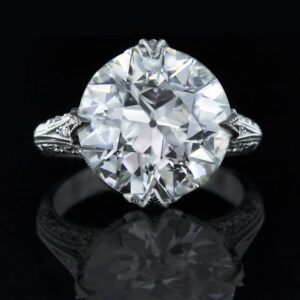
Prior to this invention “round” diamonds had a squarish outline. Morse, continually conducting research with regard to diamond’s optical properties, eventually concluded that the diamond’s proportions should be changed so as to raise the girdle to one-third of the way below the table facet and two-thirds of the way above the pavilion, bringing out a brilliance in diamonds heretofore unseen. This produced the first diamond with a truly round outline and good optical proportions; the “American cut” was born. Morse’s work with diamond proportions was later popularized by Marcel Tolkowsky leading to the so-called “ideal-cut” diamond. Field’s invention and Morse’s diamond proportions were adopted in Europe and the “European cut” was born, a name that lives on today.
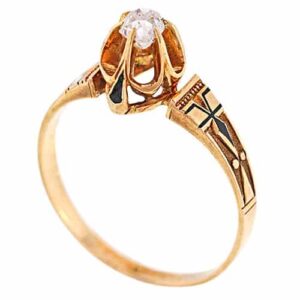
Advances in diamond cutting were augmented by equally radical advances in diamond setting. Open-backed settings, which increased the diamond’s brilliance by allowing light to enter the stone from all angles, were gaining popularity. This new openness, created by cutting the back of a collet, evolved into prong settings which in turn added even more fire and brilliance to the gems. A machine that could raise prongs by a stamping process soon followed, making gem-set jewelry even more affordable. By 1875 almost no diamond jewelry was being imported; American jewelers had turned the tide.
Colored gems continued to be prized but the list expanded to include rubies and opals. In 1833 Palmer & Clapp made the first “regard” rings by utilizing different colored gems to spell out secret sentiments. Engagement rings began to feature rubies and emeralds. The discovery of high-quality opals in Australia in 1849 and Queen Victoria’s love of the gem created a European fashion frenzy for the gem which inevitably found its way to America. Opals were paired with rubies and emeralds and eventually with diamonds as well. Large garnets were being cut en cabochon and this new style helped to retain garnet’s earlier popularity. Bohemian garnet jewelry enjoyed a resurgence with a look that harkened back to the early days of American independence. Amethyst in very large sizes also staked its claim among the popular gemstones. Turquoise, set in gold and usually combined with other gems, was a new and exciting fashion trend. It was believed that the combination of turquoise and ruby signified love. Turquoise with pearls created another intriguing and popular combination.
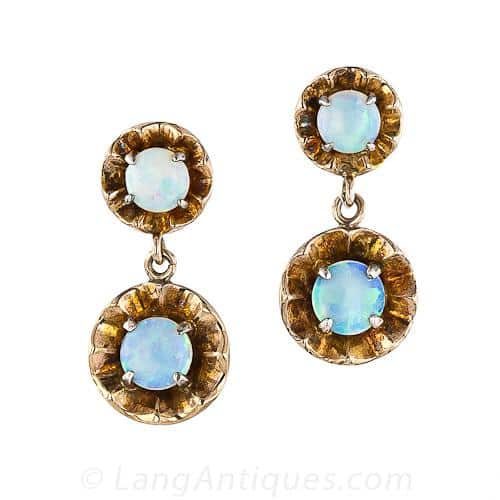
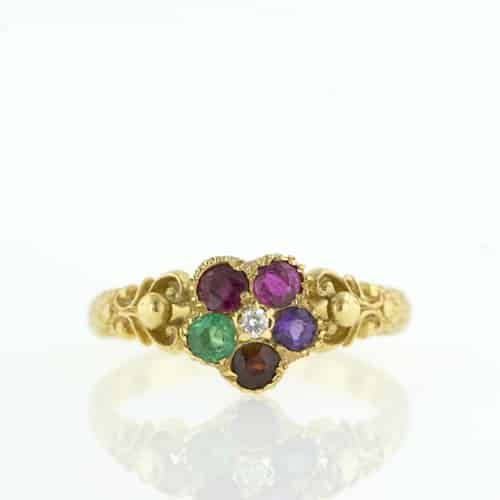
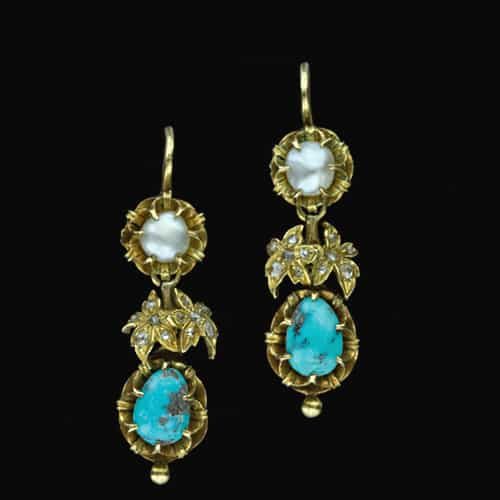
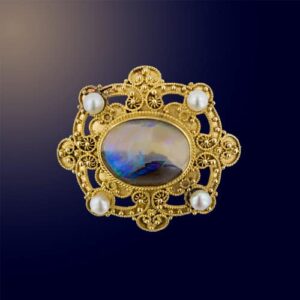
Exciting new styles included jewelry inspired by ancient Egypt and Etruscan revival jewelry based on the artifacts recovered from ancient Etruscan burial sites. Etruscan Revival’s distinctive decorative elements include the extensive use of granulation and filigree. Fortunato Pio Castellani rediscovered the technique for granulation after studying this newly recovered ancient jewelry. Castellani’s work became very fashionable in Europe and his jewelry, purchased by wealthy tourists, spread the Etruscan revival style throughout the world. Americans embraced the style and American jewelry makers began to produce their own versions, lending it a certain cache by pretending to import it from Europe.
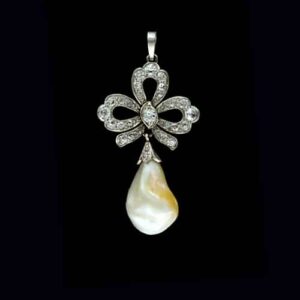
The discovery of new, more abundant deposits of freshwater pearls in America further fueled the desire for elaborately woven pearl designs. Slices of mother-of-pearl continued to serve as the template and infrastructure for these intricate designs although they now had the addition of gold for strength. The natural themes so prevalent during this period were evident as well in the new pearl designs. Gone were colored gemstones mixed with pearls as all white compositions were desired and deemed flattering to all who wore them. These magnificent creations became a necessity for every bride. Tiffany created a seed pearl set that was purchased by Abraham Lincoln and worn by Mrs. Lincoln to the Inauguration. This old-style European design was now an American tradition.
Hair jewelry continued to be popular for remembrance and friendship, with the designs becoming more and more elaborate, woven and puffed into amazing forms and shapes. With the onset of the Civil War, this form of memento jewelry became more popular than ever. Along with hair jewelry, portrait miniatures became larger, often too large to even be worn. This art form died an abrupt death however in 1839 with the invention of the daguerreotype. Ready-made brooches and pendants appeared in the shops waiting only for the customer to provide the daguerreotype of the loved one to complete the piece. Sometimes the miniaturist’s skill was still called for in applying color to the daguerreotype portraits. These Civil War daguerreotypes were often combined with hair jewelry to create a complete remembrance of someone gone to war or one who would never return.
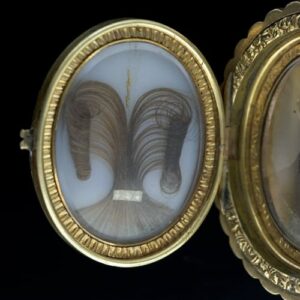
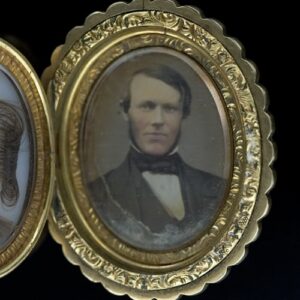
In Europe, a great many new materials were being used in what is now referred to as “tourist” jewelry. Travelers returning from Europe brought tortoise shell souvenirs home and demand grew. Jewelers began to import these new jewelry items to satisfy the growing desire for them in the United States. American jewelers imported hawk’s bill turtle shells in order to carve their own hair combs, chains, brooches, etc. American ingenuity and newly invented machinery allowed American designers the freedom to reinvent this tortoise shell jewelry in the “American taste”. Bold pique designs appeared, much grander than any produced in Europe. Along with the genuine come the imitations and vulcanite, horn and celluloid began to appear on the American market circa 1850. As hairstyles became less complex though, the booming hair comb business died out.
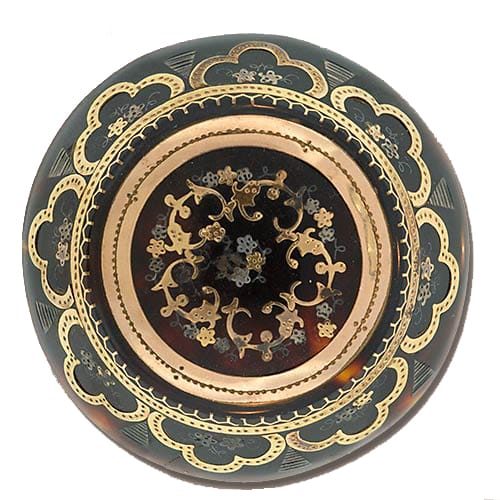
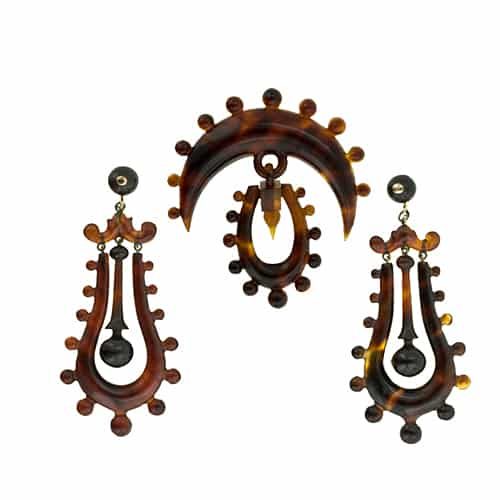
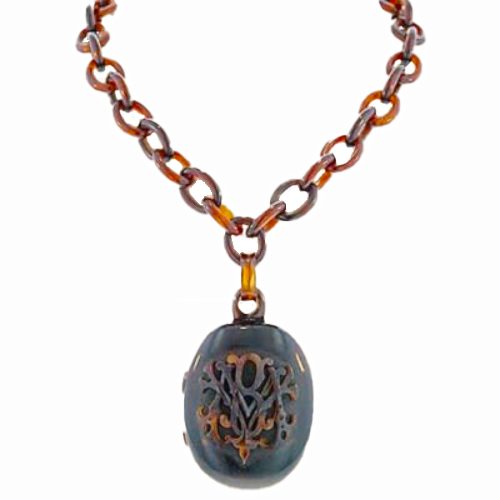
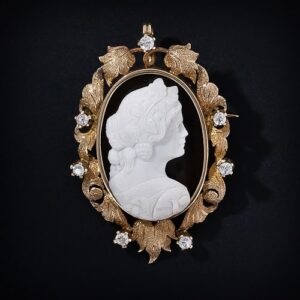
A revival of the use of cameos in American jewelry coincided with a rise in the number of trained sculptors with the necessary skills to produce these fine carvings. As these artisans could not readily sell their large, highly-priced sculptures, they created smaller more manageable carvings in the form of cameos that were affordable and purchased by a much wider audience. Portrait cameos helped fill the gap between miniature painting, which was going out of style, and photographic portraits which were still in their infancy. Cameos could be produced using a variety of shell materials as well as hardstone. In America, black onyx backgrounds with white carvings were the most desired. The Centennial Exhibition in Philadelphia in 1876 featured vast displays of cameos from around the world, including those carved by traditional Italian and German designers, which were displayed alongside those made in America. New materials used for carving cameos included lava, coral, and imitations such as glass and celluloid.
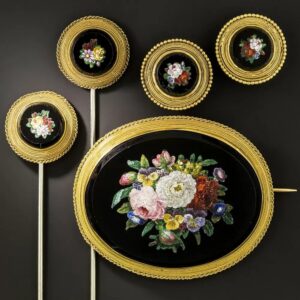
A long-held Roman tradition of creating mosaics with classical themes, made from tiny pieces of glass called tesserae, was finding its way to America. Around 1840 mosaic jewelry began to appear in American portraits. Enterprising jewelers, including Tiffany, took advantage of the popularity of these tourist pieces and began importing these miniature works of art. Imported mosaics set by American jewelers were far superior to any tourist jewelry items available in Rome. At the 1876 Philadelphia Centennial Exhibition, a portrait of Abraham Lincoln done in a micromosaic further increased the American interest in this medium.
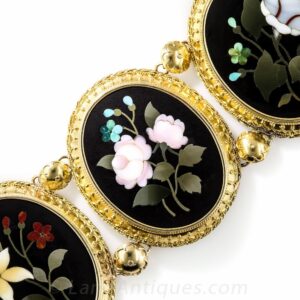
Florentine-style mosaics were also popular and adapted readily to the American taste. These mosaics, referred to as pietra dura, were composed of larger carved gemstones arranged jigsaw puzzle style within black marble. Malachite and lapis lazuli, because of their vivid color, were particularly favored in these pieces. Floral motifs composed of a myriad of gemstones, from simple to elaborate, were the most prolific theme. These mosaics were deemed acceptable daytime wear for a proper lady, thereby increasing their popularity. In addition, Florentine mosaics were not only created for use in jewelry but also for use as table tops and other decorative objects.
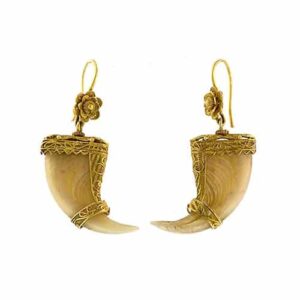
Jewelry that featured souvenirs of big game hunting was being worn by women in England. The look proved popular enough that Tiffany began to design jewelry that featured tiger claws with intricate mountings. “The claws were turned into a pleasing and unferocious ornament.”2 Another material derived from hunting was ivory and, while widely popular in Europe, in America the less expensive imitations such as bone and celluloid were more likely to be worn. Another substitute for ivory was a clay-like material called Meerschaum which was carved into cameos and other decorative objects.
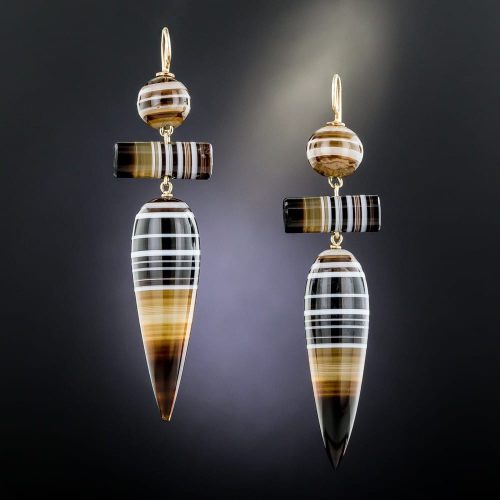
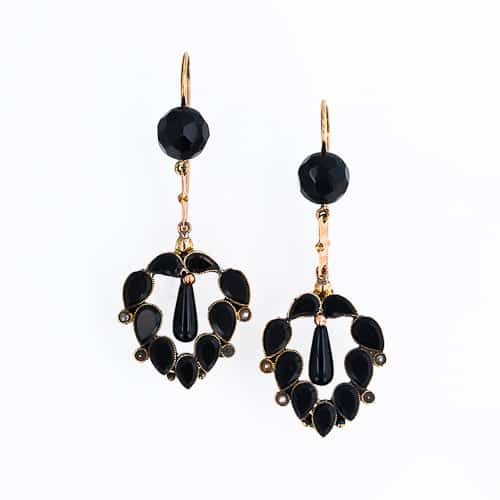
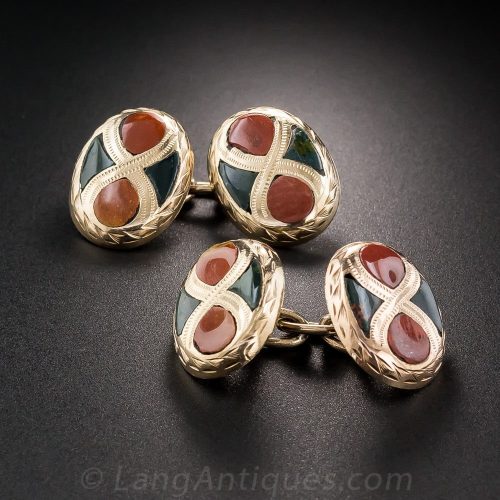
Victoria’s long period of mourning had its effect on American jewelry as well. While mourning conventions were prevalent in the United States, they were not typically as severe as those imposed by Queen Victoria’s mourning of Prince Albert. Nevertheless, jewelry designed to be worn during mourning, including items made from jet and black onyx, along with Scottish pebble jewelry found its way into American fashion. As American jewelers began to produce their own versions they discovered that they had the necessary natural resources close at hand. Banded agate, carnelian, and other similar stones were all available, and jet from Colorado, as fine as any found in Whitby, was being sent to England for carving. When Victoria’s mourning finally lifted in 1887, jet and all its imitations soon disappeared from fashion.
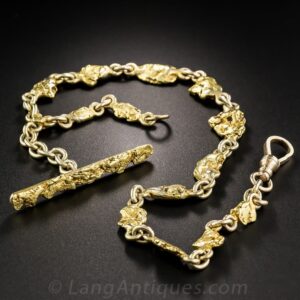
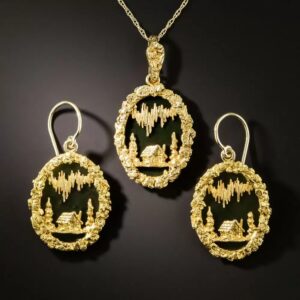
Gold and silver were still the metals of choice for fine jewelry making although gold was gaining over silver as the preferred metal for stone setting. Alloys of various colors of gold came on the scene and designs began to incorporate multiple colors of gold. New techniques for finishing as well as patterning and texturing on gold, added new dimension to jewelry design. Granulation, Florentine finishes, matte surfacing, (including a process that involved a scratch brush on a lathe lubricated with beer) and gilding were among the new gold finishing techniques.
The California Gold Rush provided not only raw materials, in the form of gold bars assayed and shipped directly from California to jewelers in New York and Newark, but it also provided inspiration for jewelry design. Digger’s brooches, stickpins, vest buttons, rings and other items, all with gold nuggets, were popular examples of gold rush jewelry. A San Francisco firm located on Sutter Street called the California Jewelry Co., became known for its fine “California” style jewelry. In the hopes that they could provide not only tourist souvenirs of a California visit, but they also attempted to provide the west coast with every kind of jewelry necessity. They patented buckle designs and specialized in jewelry utilizing the local gold-in-quartz. This gold-in-quartz from the California gold fields was inlaid in watch chains, matchboxes, pins, buckles, lockets, pendants, rings and other objects of truly American jewelry design.
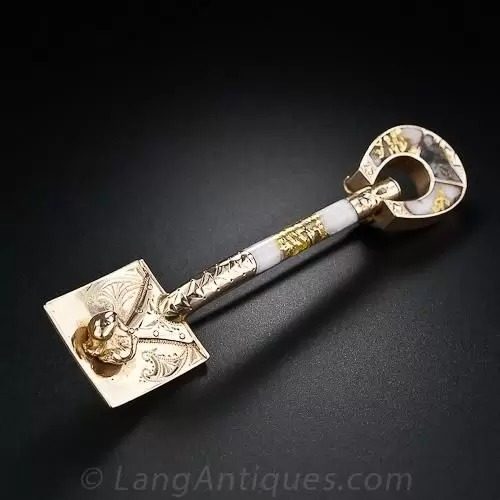
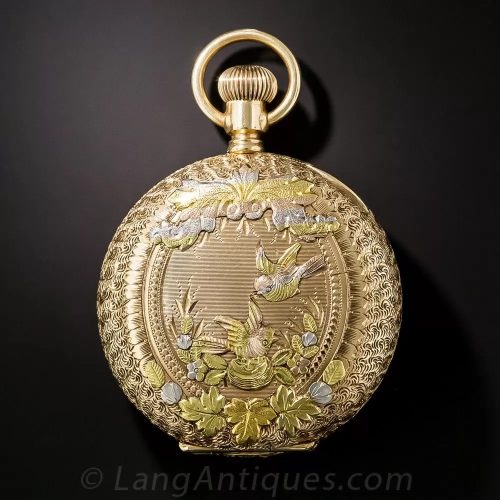
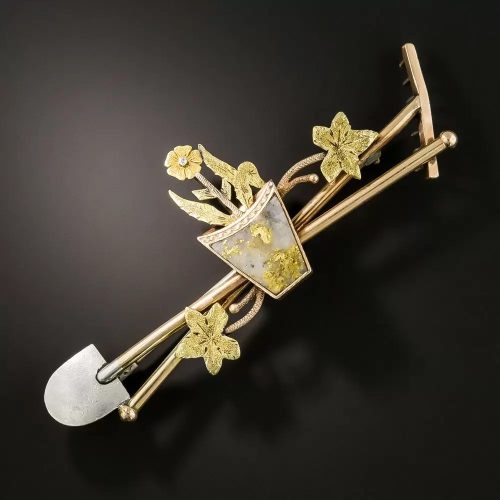
Timeline: Part III
| Name/Period | Year | Company Info | Specialty |
|---|---|---|---|
| Fletcher and Gardiner Philadelphia PA | ?-1842 |
|
|
| Benjamin Shreve (1813-1896) Saco ME Later New York | 1828 |
|
|
| Louis Jaccard St. Louis MO | 1829 |
|
|
| Caldwell & Bennett J. E. Caldwell and James M. Bennett 1868 renamed J.E. Caldwell Philadelphia PA | 1830s |
|
|
| Baily & Co. Philadelphia PA | 1832 |
|
|
| Elijah Peacock Charles Peacock (1838-1903) Chicago IL  | 1837 |
|
|
| Charles Tiffany Tiffany, Young & Ellis Tiffany & John P. Young 259 Broadway NY   | 1837 |
|
|
| Ball, Black & Company New York, NY   | 1839 |
|
|
| Charles Goodyear | 1839 |
|
|
J. Gorham & Son | 1841 |
|
|
| Alling & Co. Newark NJ 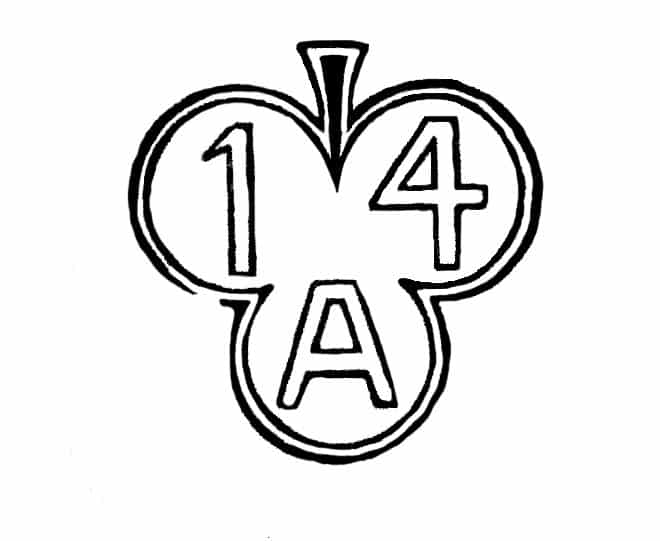 | 1843 |
|
|
| Carter, Gough & Co. Newark NJ 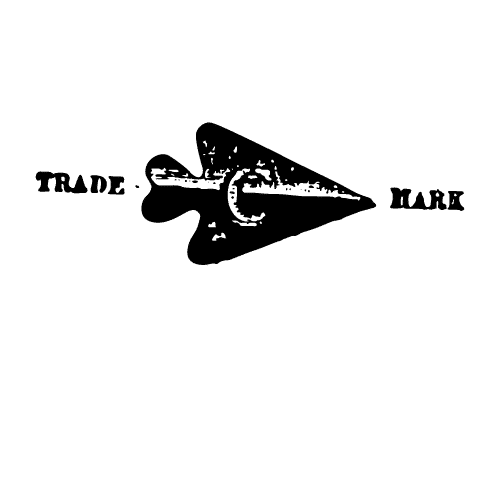 | 1841 |
|
|
| Riker & Tay Riker Brothers Newark NJ  | 1846 |
|
|
| Gold Rush Sutter's Mill California | 1849 |
|
|
| Jones, Ball & Poor Boston MA 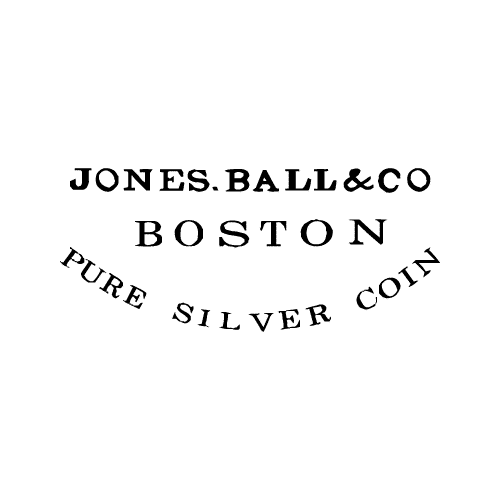 | 1849 |
|
|
| Herman Marcus New York NY | 1850 |
|
|
| Trade Treaty with China | 1853 |
|
|
| Tiffany & Co. Moved to 550 Broadway NY   | 1853-1870 |
|
|
| George Shreve (1828-1893) Apprentice to Benjamin   | 1852 |
|
|
| 16 Watchcase Companies Philadelphia PA | c.1857 |
|
|
| Silver Discoveries in America | 1859 |
|
|
| Crosby & Morse Samuel T. Crosby Henry D. Morse Boston MA | 1860 |
|
|
| Gump’s San Francisco CA 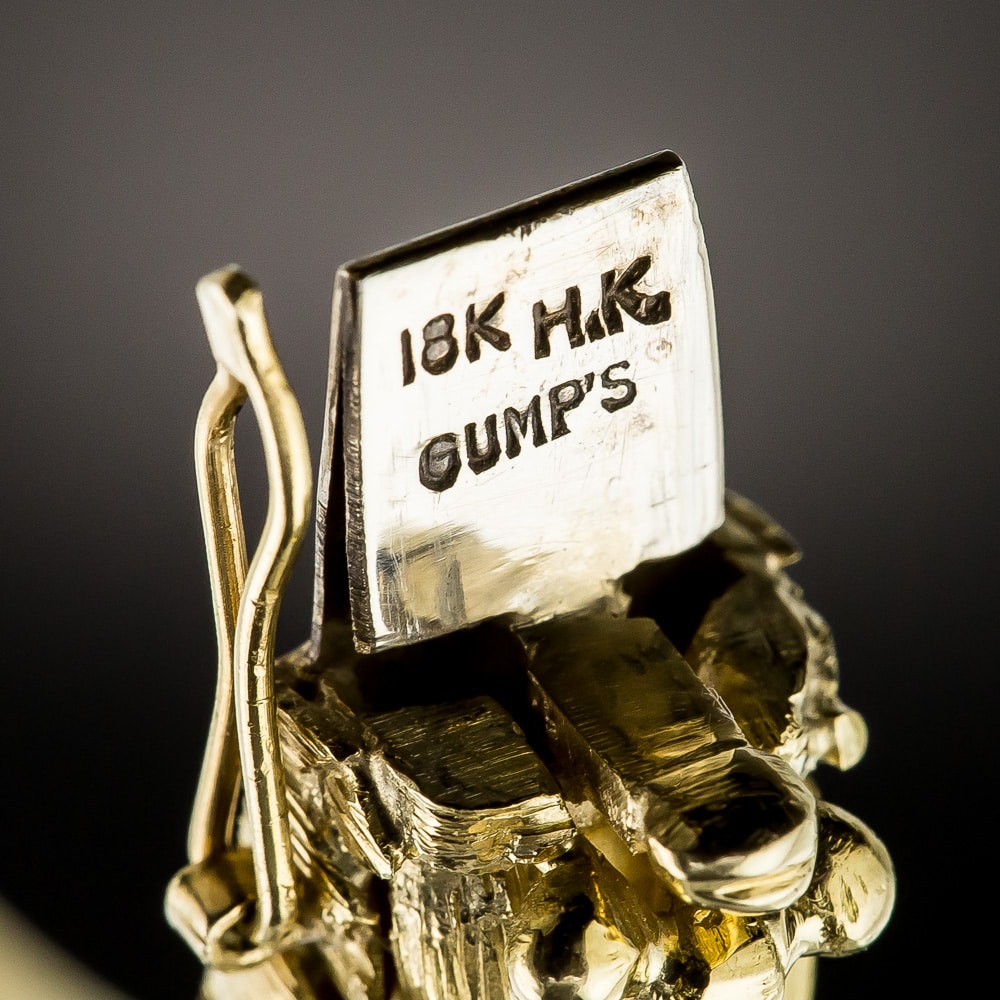 | 1861 |
|
|
| Theodore B. Starr (1837-1907) Starr & Marcus John Street NY  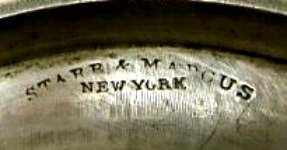 | 1864 |
| |
| Gorham Manufacturing Company | 1865 |
|
|
| Larter & Sons John Street NY Newark NJ  | 1865 |
|
|
| Krementz & Co. Newark NJ  | 1866 |
|
|
| Paris Exposition Paris, France | 1867 |
|
|
| Greenleaf & Crosby Jacksonville FL | 1867 |
|
|
| J.E. Caldwell Co. Chestnut Street Philadelphia PA 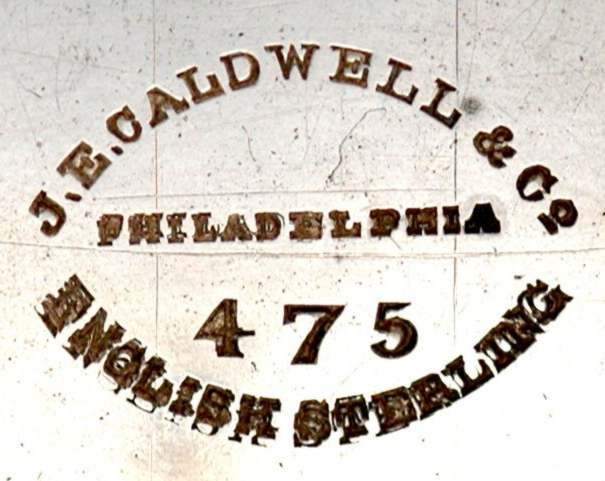 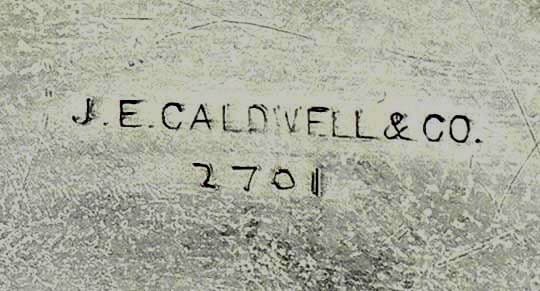 | 1868 |
| |
| William Shreve (1835-1919) | 1869 |
| |
| Unger Brothers Newark NJ 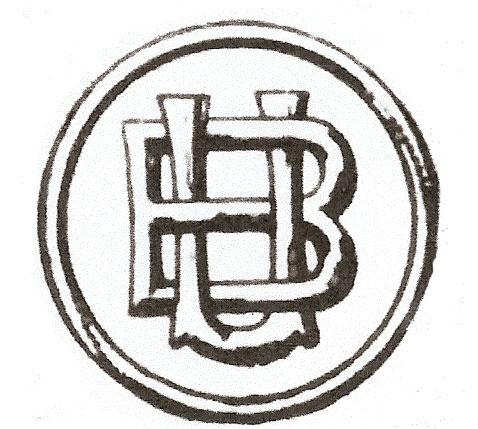 | 1870 |
|
|
| Cortlandt W. Starr (1833-1888) Black, Star & Frost 1876 B, S & F moved to 251 Fifth Ave. New York NY  | 1874 |
|
|
| Jewelers’ Circular and Horological Review New York NY | 1874 |
|
|
| John Ruskin & Charles Eliot Norton Boston MA | 1874 |
|
More American Jewelry
Sources
- Dietz, Ulysses Grant; Joselit, Jenna Weissma; Smead, Kevin J.; and Zapata, Janet. The Glitter & the Gold: Fashioning America’s Jewelry, Newark NJ: The Newark Museum, 1997.
- Fales, Marthy Gandy. Jewelry in America 1600-1900: Woodbridge, Suffolk England: Antique Collectors’ Club, 1995.
- Price, Judith. Masterpieces of American Jewelry. Philadelphia: Running Press, 2004.
- Proddow, Penny and Healy, Debra. American Jewelry: Glamour and Tradition: New York NY: Rizzoli, 1987.
- Romero, Christie. Warmans Jewelry: Radnor PA: Wallace-Homestead Book Company, 1995.
- “The Pioneer Lapidary: Death of H.D. Morse the Well Known Dealer in Diamonds.” New York Times, January 4, 1888.
